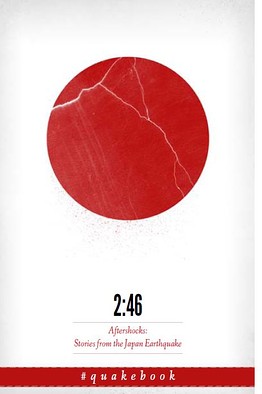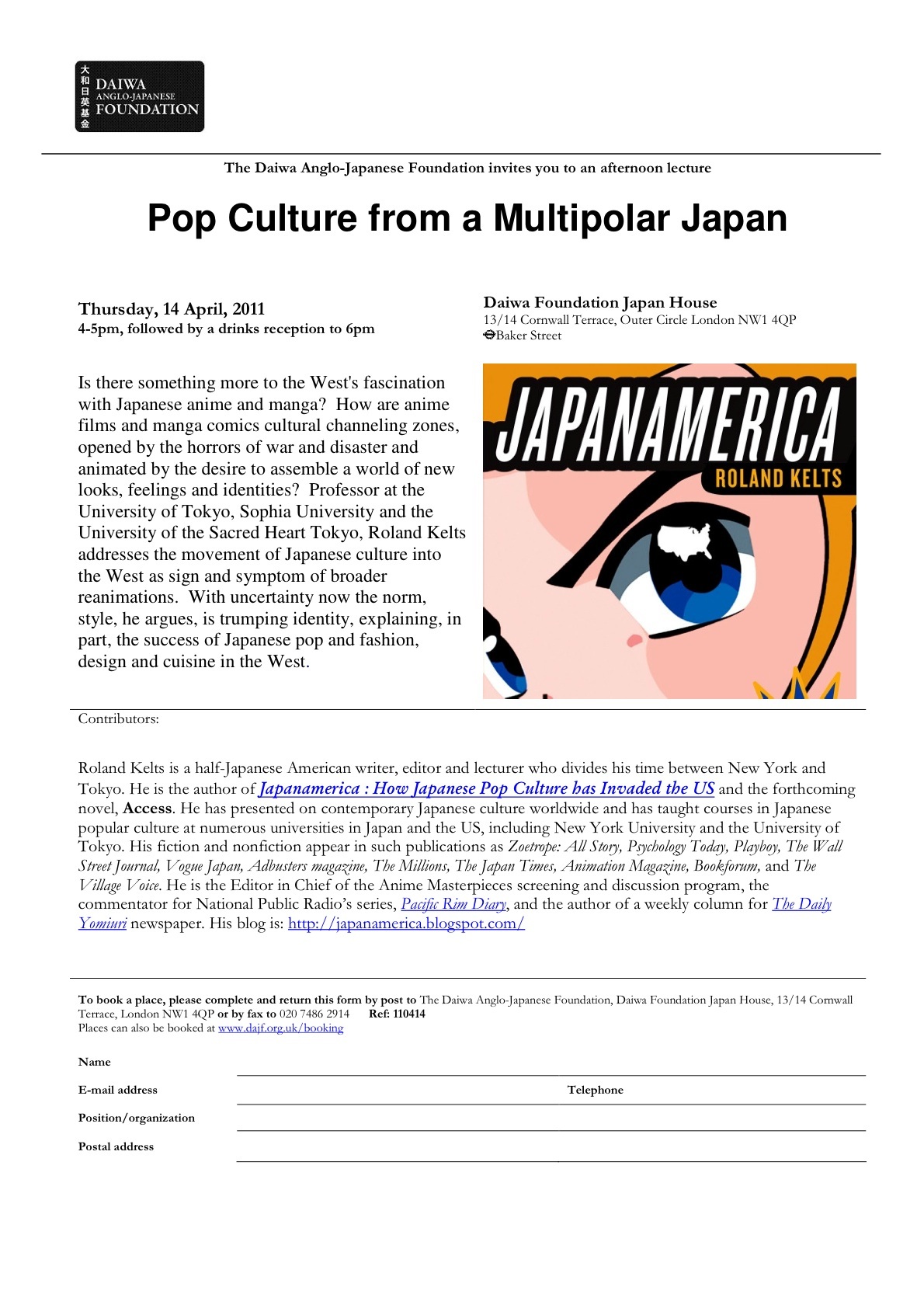Toronto Fukushima JET alum fundraising
Just noticed on Brent Stirling’s (Fukushima) blog ForYourBrentertainment an item about some Toronto JET alums (Jason Ishida and Eric Chan) who worked in Fukushima who have organized a Japan fundraising event for this coming Saturday, April 9 at Orville’s Pub as well as an additional fundraiser on Sunday, April 10 at the Toronto Buddhist Church Social Hall.
 Fukushima City JET Brent Stirling recently put out word to JETAA chapters about Quakebook, “a book of stories, art and photographs that reflected first person accounts of the disaster” which will soon be available on Amazon.com with all proceeds going to benefit the Japan Red Cross. Brent contributed his own story and has also offered to help with marketing and spreading the word. Below Brent provides some insight into the unique process that led to the creation of of the project as well as his own involvement.
Fukushima City JET Brent Stirling recently put out word to JETAA chapters about Quakebook, “a book of stories, art and photographs that reflected first person accounts of the disaster” which will soon be available on Amazon.com with all proceeds going to benefit the Japan Red Cross. Brent contributed his own story and has also offered to help with marketing and spreading the word. Below Brent provides some insight into the unique process that led to the creation of of the project as well as his own involvement.
I lived in Fukushima City from August 2006 to August 2010 and worked as an ALT there. The recent earthquake, tsunami and nuclear crisis in Tohoku has had me glued to my computer since it began, as has probably been the case with all JET Alumni. Keeping in contact with my friends in Fukushima-ken through Facebook and Twitter, I felt helpless as far as how to help and what to do.
With limited access to news in the first days after the quake, I compiled information from friend’s Facebook status updates, Twitter and a variety of news sources. I sent these updates via Facebook to my friends who didn’t have the time to comb through the news in order to get an accurate picture of what was going on. Updates included news about transportation, gas, areas with running water, wind directions, reactor conditions and radiation levels. Facebook became a source of news for everyone in the prefecture. The current and former Fukushima JET community along with Japanese people worked together in order to get a clear picture of what was going on in Fukushima.
A week after the earthquake, I was sent a link to a blog asking for contributions about the earthquake. The blogger, OurManInAbiko, hoped to create a book of stories, art and photographs that reflected first person accounts of the disaster. He vowed to edit all the submissions and donate all of the proceeds to the Japanese Red Cross. Looking to help anyway I could, I put in a submission about my experience in Canada throughout the ordeal and how proud the JETs and Japanese community had made me throughout the crisis. My submission discusses sensationalism in the media and how the JET community worked together using social media to overcome adversity and share accurate news on the situation as it unfolded. I didn’t know that within 15 hours, OurManInAbiko had received 74 eyewitness submissions from all over Japan, as well as reactions from elsewhere in Asia, Europe and North America.
Through Twitter, the idea of #Quakebook grew. Just as the Fukushima-ken JETs had used social networks in order to keep in contact, #Quakebook was using the networks in order to promote and create a book. People joined in to spread the word and help with the logistics of publishing a book of this magnitude in such a short span of time. Soon after, writer, William Gibson wrote a piece for the book, then Jake Adelstein contributed, Yoko Ono has recently come on board, offering her own piece in Japanese and English Through the work of so many on Twitter from all over the world, #Quakebook began to take off. Articles appeared on the BBC website, the Wall Street Journal and CNN Go to name a few. Amazon has agreed to publish the book, waiving all of their fees with 100% of the money going to the Japanese Red Cross. The all-volunteer team of #Quakebook is now working at getting translations of the book into different languages so that it can be a truly worldwide phenomenon.
The group that comprises the Quakebook team is continually growing. Every person involved is using their skills and their own contacts in order to get the word out to every corner of the globe. The team, while working closely is completely anonymous as everyone is referred to by their Twitter names. My role has been very small throughout the Quakebook marketing process, but I believe in the book and I think it has the potential to bring people who are otherwise removed from the situation in Japan closer to it. In buying the book, not only are people making a donation to the Japanese Red Cross, but they’re also getting the stories of the people involved, the people that this disaster has affected.
I know that all JET Alumni are tied to Japan the same way that I am. Everyone’s time in Japan had a profound affect on where they are now and what they’ve done with their lives. I’m hoping that this connection to Japan will get JET Alumni Associations worldwide to support and promote this book as best they can. By putting a link to the Quakebook website on your blog, printing Quakebook posters for around your neighbourhood or your local library or getting it into the media wherever you are, everyone can make a difference in this project and help with the relief efforts in Japan.
- Pre-order the book at www.quakebook.org
- Excerpts from Quakebook
- Brent’s re-work of his submission
Roland Kelts helps launch debut issue of “MONKEY BUSINESS: New Voices from Japan” with April/May events in NYC
******************
Via Roland Kelts (Osaka-shi, 1998-99), author of Japanamerica and the contributing editor for MONKEY BUSINESS: New Voices from Japan:
A Letter from A Public Space (Brooklyn-based literary publication):
A Public Space Literary Projects announces the debut issue of MONKEY BUSINESS: New Voices from Japan, with April/May launch events in New York City.
New York City, New York, April 4, 2011—A Public Space (APS) announces publication of the first annual English language edition of Monkey Business: New Voices from Japan (MB), supported by a generous grant from the Nippon Foundation. Three launch programs in New York City in late April and early May will bring together authors, translators and editors from Japan and the US for this first-of-its-kind trans-cultural literary event. Twenty-five percent of all MB sales will go toward the Nippon Foundation/CANPAN Northeastern Japan Earthquake and Tsunami Relief Fund.
Monkey Business is a Tokyo-based Japanese literary magazine founded in 2008 by award-winning translator, scholar, editor and author Motoyuki Shibata. One of Japan’s best known and most highly regarded translators of American fiction, Shibata has won numerous accolades, most recently the 2010 Japan Translation Cultural Prize for his translation of Thomas Pynchon’s Mason & Dixon, and has introduced to Japanese readers works by Paul Auster, Steven Millhauser, Rebecca Brown, Stuart Dybek and Steve Erickson, among others.
Shibata, who was interviewed in the first issue of APS, modeled MB in part on the Brooklyn literary journal. Founded in 2006 by editor Brigid Hughes, A Public Space is devoted to cutting-edge literature—not just from American contributors, but by writers and artists spanning the globe. Each issue presents a portfolio that explores an international literary scene. The debut issue of APS featured a portfolio from Japan, curated and edited by author Roland Kelts (Japanamerica) and MB founder Shibata, and featuring contributions from Haruki Murakami, Yoko Ogawa, Kazushige Abe and others. Issue 1 was praised by readers in the US and Japan and has long been sold out.”
Read More
WIT Life #159: UN Messages of Solidarity with Japan
WITLife is a periodic series written by professional Writer/Interpreter/Translator Stacy Smith (Kumamoto-ken CIR, 2000-03). She starts her day by watching Fujisankei’s newscast in Japanese, and here she shares some of the interesting tidbits and trends together with her own observations.
Last week I had an interpreting assignment at the United Nations Department of Public Information, and while there I had the chance to learn about a new webcast series featuring UN Messengers of Peace showing their support of Japan during this time of crisis. Currently there are 8 of these public service announcements with the bilingual tagline “Japan we are standing by your side (みなさんを応援しています).” They are offered by prominent figures such as Ban Ki-moon and Michael Douglas, and I particularly like the one of Stevie Wonder which closes with him saying, “Japan, I love you!” to the tune of his famous song. All of the spots have Japanese translations at the bottom, and they are scheduled to be shown in Japan by NHK and other providers. They began at the end of March and are scheduled to continue throughout the year, so make sure to check them out as new messages are added!
Event: JET alum author Roland Kelts to speak in London April 14
*******
Attention JETAA UK! Join Roland Kelts (Osaka-shi, 1998-99), author of Japanamerica, at The Daiwa Anglo-Japanese Foundation in London on Thursday, April 14 for a talk on “Pop culture from a Multipolar Japan.” Talk is 4-5 pm followed by drinks reception to 6pm.
Note: If you plan on attending, please register for the event at http://www.dajf.org.uk/events/booking-form
Surviving In Japan: How to Find Out How Fast Your Laundry Will Dry
Posted by Ashley Thompson (Shizuoka-ken, 2008-2010) of Surviving in Japan: without much Japanese and Lifelines columnist for The Japan Times.
You probably already know that most people in Japan hang out their laundry to dry. Drive or ride past apartment buildings on a sunny day and you’ll see clothes, towels, blankets and futons hanging from bars and draped over the rail. And what could be better than to have the sun dry and naturally remove odors and stains from your items? It’s a wonderful thing. Well, at least when you don’t have the strong winter wind like here in Shizuoka attempting to throw your stuff over the ledge (I’ve gotten quite clever at coming up with ways to keep things from blowing off the balcony).
And you probably also know that you wouldn’t hang clothes outside if it’s raining or looks like it’s going to rain.
But what if you could know how fast your clothes might dry on any given day?
There’s a neat tool on various weather websites that determines a “laundry index” or 洗濯指数 (せんたくしすう, sentaku shisuu) – essentially it tells you if it’s a good day for hanging out laundry or not and how quickly certain items will dry.
For this example I’m going to use tenki.jp, though you can find the laundry index on Yahoo and other sites as well (and they are all the same so I can’t say one is better than another).
First, go to tenki.jp, and then click on 指数情報 (しすうじょうほう, shisuu jouhou – sort of like “index information”), as in the picture below. (There’s actually a map of Japan in that blank gray box but it didn’t show up in my screenshot for some reason.)

Next, choose 洗濯 (せんたく, sentaku, laundry). — CLICK HERE to read the rest of the post.
 The April 2011 issue of the Sake World e-newsletter by JET alum and the leading non-Japanese sake expert in the world, John Gauntner (a.k.a. “The Sake Guy”), is now available online.
The April 2011 issue of the Sake World e-newsletter by JET alum and the leading non-Japanese sake expert in the world, John Gauntner (a.k.a. “The Sake Guy”), is now available online.
In this issue:
- Greetings
- Good rice? Bad rice?
- The Current Situation in Japan
- Announcements and Events: Sake Professional Course in NYC
- Did you Know?
- Sake Basics
- Sake Education Central
CLAIR 2011 “JET Streams Newsletter”
Via CLAIR Tokyo:
Dear JET alumni,
- Here’s a link to the online version of this year’s JET Streams newsletter: http://www.jetprogramme.org/e/former/jetstreams.html
- Here’s a link directly to the PDF: http://www.jetprogramme.org/documents/pubs/JET%20STREAMS2011.pdf
JET Streams is distributed once a year to all JET alumni who request it and have registered their email address with CLAIR. Be sure to keep your email address updated so that you keep receiving JET Streams.
CLAIR would like to thank all the JETAA chapters and current/former JETs who contributed articles for this year’s JET Streams.
Table of Contents
- Greetings from Yoko Kimura, Chairperson of the Board of Directors
- JETAA Singapore: The New Kid on the Block
- JETAA Tokyo: A Closer Look
- JET Alumni Voices:
- Lorelei Cortez (Hyogo-ken, Santo-shi, 2004-07) of JETAA Northern California
- “Better Than a Thousand Days of Diligent Study” – Cristy Burne (Hyogo-ken, 1998-00) of JETAA Western Australia (Perth)
- “Shashinka – A Cultural and Visual Inspiration” – Stirling Elmendorf (Tokushima-ken, 2001-04) of JETAA Northern California
- Current JET Perspectives: “JET Island Life: Photographic Perspectives”
- JETAA International Meeting in Scotland
- Introduction of 2011-12 JETAA International Executive Committee
- Setting Up a JETAA Chapter
- From CLAIR Department of JET Program Management
- JETAA Chapter Representatives/Information
- Cartoon: “Final Thoughts” by David Namisato (CIR Aomori-ken, Ajigasawa-machi)
- “Words from the Editor” by Christian Tsuji
Minamisanriku JET Kathryn Oi shares her experience of the earthquake and tsunami
Kathryn Oi (Miyagi-ken, Minamisanriku-shi) has shared a deeply personal description of her experience in the midst of one of the hardest hit towns by the earthquake and tsunami–Minamisanriku, which has lost approximately half of its 18,000 residents. The link below to the written piece which appears on the Claremon-McKenna College website where Kathryn went to college also includes a slideshow of before-and-after photos taken by Kathryn.
http://www.claremontmckenna.edu/news/japan2011.php
Katie Oi ’10 was teaching at a junior high school in Japan when the earthquake and tsunami hit the island. She offers the following firsthand account of the week following the disaster and her journey to safety. Katie is now back at home in Seattle, WA.
After a two hour nap or even a night’s long rest, I wake up suddenly feeling uneasy with a feeling like I had a bad dream somewhere deep within my slumber. It takes me even a few seconds to process where I am—back home in the comfort of my own bed—when it was just two weeks ago I was pinned in the heart of Mother Nature’s deadliest attack on Japan. I have to keep telling myself that the past two weeks were not a dream. What I witnessed was real: the devastation from a M9.0 earthquake and 30-meter tsunami, but also the perseverance to rise up as a people and continue to live in spite of all that.
CLICK HERE to read the full piece on the Claremont-McKenna College website.
Correction 3/31/11: Katie e-mailed to point out that she incorrectly mentioned the tsunami as 30 meters a couple times in her piece. The actual reported height, she says, was 16 meters.
Miyagi JET writes of ruin, survival, rebuilding
The below letter by current JET Waylon Bryson (Miyagi-ken, Sendai-shi) appeared recently in the Washington State University student publication where Bryson attended college.
The following letter was sent to WSU history instructor Roger Chan, who taught author Waylon Bryson, a philosophy graduate of 2007. Chan shared it with Noriko Kawamura, associate professor of history, who passed it on for WSU Today to share with the university community. Bryson is working in Sendai, Japan as an English teacher. This fall he will attend Vanderbilt Law in Nashville, Tenn.
I have lived in the city of Sendai, Japan for the past three and a half years, where I teach English for the Japan Exchange and Teaching (JET) Programme. I was at my desk in the teachers’ room of Hachiken Junior High School when the earthquake struck.
Earthquakes are quite common in Japan and I, like the other staff members, paid little attention at first.
Then the room moved several feet. I had to physically hold onto my desk so that it wouldn’t move away from me. A control panel on the wall lit up like a Christmas tree and alarm bells started sounding. I could hear students screaming from the floors above as cracks snaked along the concrete walls and the building started groaning ominously.
CLICK HERE to read the full article on the WSU Today site.
Fukushima perspectives by a Fukushima JET alum
Thanks to JETAA Bluegrass Subchapter rep Roy Harrison for sharing the link to the excellent article by Fukushima JET alum and journalist Graham Shelby:
“JET Alum Graham Shelby put together a piece for the Louisville Courier-Journal about the experience of watching what’s happening in Fukushima from a distance that’s much greater geographically than it is emotionally.”
“Please give it a read. You’ll likely find it echoes the feelings you’ve been having for the past two weeks.”
http://www.courier-journal.com/apps/pbcs.dll/article?AID=2011303270046
WITLife is a periodic series written by professional Writer/Interpreter/Translator Stacy Smith (Kumamoto-ken CIR, 2000-03). She starts her day by watching Fujisankei’s newscast in Japanese, and here she shares some of the interesting tidbits and trends together with her own observations.
Japan’s recovery efforts continue to take place, and while it is easy to feel helpless in the face of the disaster’s aftermath we can each help out in our own small way. I would like to highlight some upcoming events that will enable you to contribute to the cause  while enjoying good food and music.
while enjoying good food and music.
First up is Dine Out for Japan Relief, a week-long event in which the 70+ participating restaurants are donating 5% of their proceeds to Japan’s tsunami recovery and relief efforts. There are many familiar Manhattan Japanese favorites like Read More
Tokyo JET alum photojournalist seeks contact with displaced Tohoku JETs
Thanks to Ed Snook of JETAA Tokyo for sharing this information:
JETAA Tokyo member Wes Cheek is planning on visiting the Tohoku region beginning Friday for a photojournalism assignment. He has expressed an interest in trying to get in touch with JETs who may have been displaced by the recent earthquake/tsunami. Additionally, Wes welcomes contact from any family or friends of JETs in Tohoku who would like him to try and get in touch with JETs.
- To contact Wes, you can e-mail Ed Snook at career [at] jetaa-tokyo.org.
- For updates on Wes and more information about his trip, go to Wes’ blog where you can find details and updates about his trip.
JETwit featured in CLAIR NY (aka Japan Local Government Center) Newsletter
Here’s a link to the Spring 2011 Issue of the JLGC Newsletter, published bi-annually by CLAIR NY (aka Japan Local Government Center).
This issue includes a feature on JETwit.com (PDF) which I was asked to write a few months ago. It’s hopefully a helpful explanation of the background and purpose of JETwit. However, post-3/11 I have to admit it also feels dated and I feel somewhat conflicted about posting it now given what’s still going on in Japan.
Japan Times: How you can help – by JET alum Ashley Thompson
A really helpful article in the Japan Times titled “How You Can Help” written by JET alum Ashley Thompson, who also writes survival tips and unique how-to’s about living in Japan at www.survivingnjapan.com. (http://search.japantimes.co.jp/cgi-bin/fl20110322a1.html)
A few readers have questions about donating supplies.
WA writes: “I have seen the tragic earthquake and tsunami incident that happened in Japan. I would love to donate food and clothes and help out as much as I can. Please tell me where I can send supplies.”
And JF: “We are a primary school in the U.K. with a new school logo and are therefore changing our school uniforms. We have an enormous amount of clothing: sweatshirts, polo shirts, etc. that we would like to donate.”
From IF: “I would like to find out a way to donate clothes and other articles to people in need in Japan. I live in Heidelberg, Germany.
“The items I have are in very good condition and others are new. Could you please tell me how to proceed?”
Right now, most organizations are strictly asking for monetary donations, not clothing or supplies. The general advice is to donate money to organizations that can quickly and easily locate and deliver necessary items to disaster-hit areas. Particularly if you live outside of Japan, the best way you can help is to donate money through a trusted charity of your choice, or one that is Japan-specific, such as the Japanese Red Cross Society, Salvation Army Japan, Oxfam Japan, JEN, Jhelp and Second Harvest Japan, to name a few. There are many more but most require Japanese- language ability to navigate online.
Cash and checks can also be sent by registered mail to The Japan Times Readers’ Fund, The Japan Times, 4-5-4 Shibaura, Minato Ward, Tokyo 108-8071, with checks payable to The Japan Times Readers’ Fund. Donations will be used to support the work of Red Cross Japan and the Japan Emergency Team, operated by Jhelp.
You may also want to search online for a group in your region that may have connections with an organization in Japan and is accepting supplies for donation. If you are currently in Japan, you can donate monetarily to any of the organizations above, an organization of your choice, or even through local convenience stores and similar venues. If you’d like to donate food or supplies, Second Harvest Japan is accepting a long list of items such as canned or packaged food, toilet paper, toiletries, over-the-counter medicines, sleeping bags, etc. You can find a comprehensive list and mailing address on the Second Harvest Japan websitee.
Jhelp is also accepting donations for food and certain supplies — see their website for more information. Also, try contacting your local prefectural office, city hall or volunteer office in Japan. Many places are collecting supplies such as blankets, diapers, and toiletries. Please do not deliver supplies yourself — this creates confusion, adds to traffic congestion, uses much-needed fuel, and makes it more difficult for relief supplies to reach disaster areas.
On the topic of monetary donations, DG writes: “I live in Toronto, Canada, and wish to send my sympathies and condolences for the loss of life and property to the Japanese people.
“I would also like to donate money to a relief effort. I know that some relief agencies are less principled than others, and divert funds to their own pockets. Are there any you would recommend?”
And PD is wondering: “I am seeking a small NGO based in Japan that is sending responders. As the leader of a national religious organization, it is my intent to send the funds we collect to Japan for use by Japanese responders.
“Can you help us identify a place where our funding could help a small group providing services to those in need? Perhaps a shelter, food operation or clinic?”
Whenever you donate money, you should ensure the organization is reputable, trustworthy and has a good track record. If looking for a “small” nonprofit organization, be extra careful and confirm it’s not a scam.
The best approach to finding a charitable organization that deserves your gift is to research and decide for yourself which organization is best. Charity Navigator/ provides listings of many charities with specific financial information and rankings. Though you won’t find Japan-specific organizations, many of these are accepting donations for the Japan relief effort or will donate directly to a Japanese charity (such as the Japanese Red Cross Society).
In addition to those mentioned earlier, other reputable and frequently recommended charities in Japan include Global Giving, Save the Children, World Vision, Mercy Corps and UNICEF. Some of these charities have financial information in English, but many do not. There are far more small organizations in Japan, but again, most require Japanese-language ability to navigate online.
Readers P and N write: “We are so sad at what has happened in Japan and we pray for the people every day.
“We are retired and have a spare room and could easily take in a small family until things settle down.”
And from RJ: “My family is concerned about the problems Japan is having with the nuclear accident, earthquake and tsunami.
“We are a family of four living in England: My wife and I have two boys, ages 19 and 12. We can offer a couple of spare rooms for a parent and child. This would just be for a few weeks until the situation is better.”
If you are not currently living in Japan, perhaps another form of giving might be a better idea (see above). While a generous offer, the logistics of moving people overseas temporarily are often more complicated and expensive than relocating to another part of Japan. Keep in mind too that most people will need housing for longer than a few weeks, especially if they were to go overseas.
If you are residing in Japan and have room to take in evacuees, you might try checking out the Couchsurfing group set up for the current crisis in Japan.
Note: There are subgroups within this Couchsurfing group for people in other countries to volunteer a place for evacuees to stay. Additionally, the Accommodate Japan Facebook group has listings of people around the world offering housing to evacuees, so they may be good to connect with.
Reader TM writes: “I would very much like to go to Japan to help. I can self-finance for many months, but would love to find a place to stay and some kind of organization to help with. What would you recommend?”
Currently, first-responders are doing their jobs and it’s best for untrained volunteers to stay where they are until the situation has been completely assessed. So, unless you are a medical professional or have disaster relief experience, for now, giving monetarily is the most helpful thing you can do.
Some general advice: Please, do not go to the disaster area alone or without an organization. After assessment is complete, and the disaster relief teams have done their work, organizations (such as Red Cross and others) will likely begin taking volunteers. This may be a few weeks to a couple months away, so best to watch for that.
For those living in Japan: If you are currently able to access the disaster areas or able to work on site, Jhelp ) is looking for volunteers.
The Association for Japan Exchange and Teaching, Smile Kids Japan and folks from Jetwit have compiled a list of prefectural volunteer organizations. Some prefectures are now accepting volunteers, while others have not yet posted volunteer information, but it may be possible to connect with one of these groups. Contacts are listed for some PVOs, but for general inquiries, contact Avalyn Beare or Michael Maher King at volunteer@ajet.net.
With the current power supply issues at Tokyo Electric Power Co. and in the Tohoku region, and with the government urging residents to conserve electricity, many people are wondering if they should be conserving electricity outside of the Kanto region (such as in Chubu, Kansai, Chugoku, etc.)
As of now, Tepco has not needed to execute all planned blackouts due to residents and businesses decreasing electricity usage in the region. However, planned outages are still scheduled and will likely continue in the coming weeks.
According to the official websites of electric companies across west and southern Japan, which includes Kansai, Chubu, Chugoku, Kyushu, and Shikoku (no information for Hokuriku), all are covering the demand of their own regions and sending extra electricity to the Kanto region. However, west and east Japan use two different electric current frequencies, 60hz and 50hz, respectively, and as there are only three converter stations in the country, very little electricity can be converted and sent (Kansai Electric’s website says maximum capacity is 1,000,000 kw). Hokkaido is also supplying electricity for the Tohoku and Kanto regions, as they run on 50hz.
So, for residents of west Japan, conserving electricity during this time is certainly a good idea and highly encouraged, though it’s not necessary to take it to any extremes. Then again, it’s better for the environment to use as little electricity as possible, and a little easier on your bank account.




